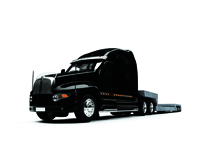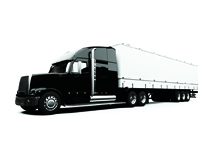 |
 |
 |
Risk Management Rules of the road: ISO changes truckers coverage Owner-operators need protection for non-business activities By Donald S. Malecki, CPCU Independent truckers make their living by contracting with trucking firms to transport cargo, but at times they may not have cargo to haul. When hauling an empty trailer or driving without a trailer attached, truckers cannot rely on trucking firms for insurance protection. They need their own coverage for these non-trucking uses of their rigs. Concepts and terms In trucking parlance, "bobtail" refers to the operation of a truck-tractor (or rig) without an attached trailer. "Deadhead" refers to the operation of a truck-tractor with an attached empty trailer. From an insurance standpoint, "bobtail" refers to the non-business activities of operating a truck-tractor without a trailer attached, whereas "deadhead" involves a truck-tractor pulling an empty trailer in a non-business activity. For many years, the ISO coverage form for these activities was known as Truckers—Insurance for Nontrucking Use. With the 2013 changes to ISO's Business Auto Policy, the new term is Motor Carriers Insurance for Non-Trucking Use. This change was made primarily because ISO eliminated the truckers coverage form and replaced it with the Motor Carriers Coverage Form. Bobtailing and deadheading are most commonly done by owner-operators of truck-tractors (lessors), who sometimes also own their own trailers. These owner-operators hire their services out to trucking firms (lessees), usually firms that are authorized by the Department of Transportation's Federal Motor Carrier Safety Administration to transport property as common or contract carriers. The reason authorized carriers use owner-operators is that it is more economical than buying and maintaining their own vehicles and hiring drivers and mechanics. The lease usually specifies that the owner of the truck-tractor will provide an operator; some leases, however, are for vehicles only. Truck-tractors and/or operators can be leased on either a permanent or a trip basis. A permanent lease usually requires that the lessor haul property exclusively for the lessee, often for a year but for no less than 30 days. A trip lease covers only the time needed to transport a shipment of property from point of origin to destination. Bobtail and deadhead exposures Bobtail and deadhead exposures arise (1) when the owner-operator is using the vehicle strictly for pleasure; (2) when the owner-operator is heading home after dropping off a load at some assigned destination; or (3) when the vehicle is being serviced or en route to or from being serviced. Under the terms of many leases, servicing is the responsibility of the owner-operator. To provide coverage for bobtail and deadhead exposures and other non-business uses of a rig, the agent or broker can add the Motor Carriers Insurance For Non-Trucking Use endorsement (CA 23 09 10 13) to the ISO Business Auto Policy (BAP). This endorsement reads: Covered Autos Liability Coverage for a covered "auto" described in the Schedule is changed as follows: 1. The following exclusions are added: This insurance does not apply to: a. A covered "auto" while used to carry property in any business. b. A covered "auto" while used in the business of anyone to whom the "auto" is rented. 2. Who Is an Insured does not include anyone engaged in the business of transporting property by "auto" for hire who is liable for your conduct.1 Note that the first part of the endorsement, which addresses both bobtail and deadhead exposures, appears to be quite clear about the exposures that are not covered. Both 1.a. and b. are so-called "while" clauses, meaning that coverage is suspended while the covered auto is being used as stated in the endorsement. Thus the endorsement in effect serves as a stopgap when owner-operators are using their rigs for strictly non-business purposes. The "Who Is an Insured" provision is modified so that the BAP does not cover the authorized carrier that may be liable for the owner-operator's conduct. An example is when an owner-operator has no return load and the authorized carrier does not pay gas mileage for returning empty. In such cases the owner-operator, instead of bobtailing or deadheading back to the point of origin, may look for other cargo to haul using the original trucking firm's ICC permit. A word of caution The Motor Carriers Insurance For Non-Trucking Use endorsement is clear and easy to read, but disputes between insurers nonetheless are common. In Hartford Ins. Co. of the Southeast v. Occidental Fire & Casualty Co., of N.C., 908 F.2d 235 (7th Cir. 1990), a trucking company's policy was found to apply, even though maintenance and repairs usually are the responsibility of the owner-operator. In this case, the owner-operator dropped off his refrigerated trailer for repairs after a buyer rejected the cargo he attempted to deliver. The owner-operator then bobtailed to a truck stop to await completion of the repairs. He was directed by the trucking company to remain in the area until the repairs were complete and then attempt a second delivery of the cargo. The owner-operator was precluded from taking other work in the interim because he was under the control of the trucking company. On his way back to pick up the repaired trailer, the owner-operator rear-ended a passenger vehicle. The court held that because the owner-operator had not completed his delivery and remained under the trucking company's control, the owner-operator was acting in the service of the trucking company at the time of the accident. Also problematic is the question of when an owner-operator is or is not using the rig for business purposes. In LeBlanc v. Bailey, 709 So.2d 743, the court ruled that an independent trucker's drive home after completing his deliveries for the day on behalf of the motor carrier/lessee was more of a personal nature than a work-related function. The owner-operator's insurance for non-business use of the rig therefore applied. In Mahaffey v. General Security Insurance Co., 543 F3d 743 (2008), however, the federal court, applying Louisiana law, found that the non-business endorsement did not provide coverage when an owner-operator had been asked to remain in the area of the motor carrier's business to be available to pick up a load when one became available. Summing up To address the exposures associated with driving their rigs when not under the control of an authorized carrier, it is imperative that owner-operators of truck-tractors and trailers purchase the Motor Carriers Insurance For Non-Trucking Use endorsement to the Business Auto Policy. Although the wording of the ISO endorsement is clear, producers should watch out for how various insurers change the language in ways that alter the application of the coverage. The longer a reworded endorsement is, the greater the chance that disputes may arise over what is and is not covered and under what circumstances. 1Copyright, Insurance Services Office, Inc., 2011, with permission. The author Donald S. Malecki, CPCU, has spent more than 50 years in the insurance and risk management consulting business. During his career he was a supervising casualty underwriter for a large Eastern insurer, as well as a broker. He currently is a principal of Malecki Deimling Nielander & Associates LLC, an insurance, risk, and management consulting business headquartered in Erlanger, Kentucky.
|
|||||
| |||||
| ©The Rough Notes Company. No part of this publication may be reproduced, translated, stored in a database or retrieval system, or transmitted in any form by electronic, mechanical, photocopying, recording, or by other means, except as expressly permitted by the publisher. For permission contact Samuel W. Berman. |

